Geophysical Prospecting of the Coptic Monastery of Apa Moses Using GPR and Magnetic Techniques: A Case Study, Abydos, Sohag, Egypt
Abstract
1. Introduction
2. Location Map and Description of the Study Area
3. Archaeological Background
4. Geological Setting
5. Materials and Methods
5.1. Magnetic Method
5.2. Ground-Penetrating Radar (GPR) Method
6. Results and Discussion
6.1. Magnetic Data Interpretation
6.1.1. Total Magnetic Field Intensity (TMI) Map
6.1.2. Butterworth High Pass (HP) Residual Map
6.1.3. First Vertical Derivative (FVD) Map
6.1.4. Analytical Signal (AS) Map
6.1.5. Tilt Angle Derivative Map (TDR)
6.1.6. Source Parameter Imaging (SPI) Technique
6.1.7. The 3D Euler Deconvolution Technique
6.2. GPR Data Interpretation
7. Integration of the Geophysical Data
8. Summary and Conclusions
Author Contributions
Funding
Data Availability Statement
Acknowledgments
Conflicts of Interest
References
- UNESCO. World Heritage Centre.mht. In Abydos, City of Pilgrimage of the Pharaohs; WHC-03/27.COM/24; UNESCO: Paris, France, 2003. [Google Scholar]
- Damarany, A.; Abdallah, H. The South Abydos Marketplace excavations (2009–2010, 2013): The monastery of Apa Moses. In Abydos in the First Millennium AD; O’Connell, E.R., Ed.; Peeters: Leuven, Belgium, 2020. [Google Scholar]
- O’Connell, E.R. Abydos in the First Millennium AD; Peeters: Leuven, Belgium, 2020. [Google Scholar]
- Damarany, A.; Cahail, K.M. The sarcophagus of the High Priest of Amun, Menkheperre, from the Coptic monastery of Apa Moses at Abydos. Mitt. Des Dtsch. Archäologischen Inst. Abt. Kairo 2016, 72, 11–20. [Google Scholar]
- Hossein, Y. A new Archaic period cemetery at Abydos. In Proceedings of the Egypt at Its Origins 3: Proceedings of the Third International Conference, ‘Origin of the State. Predynastic and Early Dynastic Egypt’, London, UK, 27 July–1 August 2008; Friedman, R.F., Fiske, P.N., Eds.; Orientalia Lovaniensia Analecta 205. Peeters: Leuven, Belgium, 2011; pp. 269–280. [Google Scholar]
- Gabr, A. The new archaic period cemetery at Abydos: Osteological report. In Proceedings of the Egypt at Its Origins 3: Proceedings of the Third International Conference, ‘Origin of the State. Predynastic and Early Dynastic Egypt’, London, UK, 27 July–1 August 2008; Friedman, R.F., Fiske, P.N., Eds.; Orientalia Lovaniensia Analecta 205. Peeters: Leuven, Belgium, 2011; pp. 281–293. [Google Scholar]
- Abudeif, A.M.; Abdel Aal, G.Z.; Masoud, M.M.; Mohammed, M.A. Geoarchaeological Investigation of Abydos Area Using Land Magnetic and GPR Techniques, El-Balyana, Sohag, Egypt. Appl. Sci. 2022, 12, 9640. [Google Scholar] [CrossRef]
- Abdelaal, G.Z.; Abbas, S.K.; Abudeif, A.; Mohammed, M. Utilizing Magnetic Gradiometer to Determine the Depth and Geometry of Subsurface Archaeological Features at Abydos Archaeological Site, Sohag, Egypt. Assiut Univ. J. Multidiscip. Sci. Res. 2022, 51, 279–308. [Google Scholar] [CrossRef]
- Conyers, L.B. Ground-penetrating radar techniques to discover and map historic graves. Hist. Archaeol. 2006, 40, 64–73. [Google Scholar] [CrossRef]
- Gaber, H.; AbdelAal, G.; Abudeif, A.; Mohammed, M. Magnetic survey of Abydos archaeological site, Sohag Governorate, Egypt. In Proceedings of the Eleventh International Conference on the Geology of Africa (ICGA—2022), Assiut, Egypt, 8–9 November 2022. [Google Scholar]
- Mohammed, M.; Abudeif, A.; AbdelAal, G.; Gaber, H. Archaeogeophysical study on the Abydos Temple site using Ground Penetrating Radar Technique, Sohag Governorate, Egypt. In Proceedings of the Fifth International Conference on New Horizons in Basic and Applied Sciences, Hurghada, Egypt, 26–29 September 2021. [Google Scholar]
- Ristić, A.; Govedarica, M.; Pajewski, L.; Vrtunski, M.; Bugarinović, Ž. Using ground penetrating radar to reveal hidden archaeology: The case study of the Württemberg-Stambol Gate in Belgrade (Serbia). Sensors 2020, 20, 607. [Google Scholar] [CrossRef] [PubMed]
- Mohamed, A.-M.S.; Atya, M.; AbouAly, N.; Farragawy, K.E.; Hegazy, E.E.; Saleh, M.; Kabeel, K.; El-Mahdi, A.A. Mapping the archaeological relics of catacombs at Northeast Saqqara using GPR data, Egypt. NRIAG J. Astron. Geophys. 2020, 9, 362–374. [Google Scholar] [CrossRef]
- Ibrahim, H.A.; Ebraheem, M.O. Ground-penetrating radar reflections and their archaeological significances at two ancient necropolis tombs in Kharga Oasis, Egypt. Near Surf. Geophys. 2020, 18, 713–728. [Google Scholar] [CrossRef]
- Ahmed, S.B.; El Qassas, R.A.; El Salam, H.F.A. Mapping the possible buried archaeological targets using magnetic and ground penetrating radar data, Fayoum, Egypt. Egypt. J. Remote Sens. Space Sci. 2020, 23, 321–332. [Google Scholar] [CrossRef]
- Yilmaz, S.; Balkaya, Ç.; Cakmak, O.; Oksum, E. GPR and ERT explorations at the archaeological site of Kılıç village (Isparta, SW Turkey). J. Appl. Geophys. 2019, 170, 103859. [Google Scholar] [CrossRef]
- Gaber, A.; El-Qady, G.; Khozym, A.; Abdallatif, T.; Kamal, S.A. Indirect preservation of Egyptian historical sites using 3D GPR survey. Egypt. J. Remote Sens. Space Sci. 2018, 21, S75–S84. [Google Scholar] [CrossRef]
- El-Haddad, B. Evolution of the Geological History of the Egyptian Nile at Sohag Area Using Sedimentological Studies and Remote Sensing Techniques. Master’s thesis, Geology Department, Faculty of Science, Sohag University, Sohag, Egypt, 2014. [Google Scholar]
- Mekkawi, M.; Arafa-Hamed, T.; Abdellatif, T. Detailed magnetic survey at Dahshour archeological sites Southwest Cairo, Egypt. NRIAG J. Astron. Geophys. 2013, 2, 175–183. [Google Scholar] [CrossRef]
- Leucci, G.; Miccoli, I.; Barbolla, D.F.; De Giorgi, L.; Ferrari, I.; Giuri, F.; Scardozzi, G. Integrated GPR and ERT Surveys for the Investigation of the External Sectors of the Castle of Melfi (Potenza, Italy). Remote Sens. 2023, 15, 1019. [Google Scholar] [CrossRef]
- Gaber, A.; Gemail, K.S.; Kamel, A.; Atia, H.M.; Ibrahim, A. Integration of 2D/3D ground penetrating radar and electrical resistivity tomography surveys as enhanced imaging of archaeological ruins: A case study in San El-Hager (Tanis) site, northeastern Nile Delta, Egypt. Archaeol. Prospect. 2021, 28, 251–267. [Google Scholar] [CrossRef]
- Mohamed, A.; El-Hussain, I.; Deif, A.; Araffa, S.; Mansour, K.; Al-Rawas, G. Integrated ground penetrating radar, electrical resistivity tomography and multichannel analysis of surface waves for detecting near-surface caverns at Duqm area, Sultanate of Oman. Near Surf. Geophys. 2019, 17, 379–401. [Google Scholar]
- Leandro, C.G.; Barboza, E.G.; Caron, F.; de Jesus, F.A. GPR trace analysis for coastal depositional environments of southern Brazil. J. Appl. Geophys. 2019, 162, 1–12. [Google Scholar] [CrossRef]
- Ebraheem, M.; Ibrahim, H. Detection of karst features using ground-penetrating radar: A case study from the western limestone plateau, Assiut, Egypt. Environ. Earth Sci. 2019, 78, 563. [Google Scholar] [CrossRef]
- Elkarmoty, M.; Colla, C.; Gabrielli, E.; Papeschi, P.; Bonduà, S.; Bruno, R. In-situ GPR test for three-dimensional mapping of the dielectric constant in a rock mass. J. Appl. Geophys. 2017, 146, 1–15. [Google Scholar] [CrossRef]
- Conyers, L.B. Ground-Penetrating Radar for Geoarchaeology; John Wiley & Sons: Hoboken, NJ, USA, 2016. [Google Scholar]
- Orlando, L.; Michetti, L.M.; Belelli Marchesini, B.; Papeschi, P.; Giannino, F. Dense georadar survey for a large-scale reconstruction of the archaeological site of Pyrgi (Santa Severa, Rome). Archaeol. Prospect. 2019, 26, 369–377. [Google Scholar] [CrossRef]
- Conyers, L.B. Interpreting Ground-Penetrating Radar for Archaeology; Routledge: London, UK, 2016. [Google Scholar]
- Booth, A.D.; Szpakowska, K.; Pischikova, E.; Griffin, K. Structure of an ancient Egyptian tomb inferred from ground-penetrating radar imaging of deflected overburden horizons. Archaeol. Prospect. 2015, 22, 33–44. [Google Scholar] [CrossRef]
- Conyers, L.B.; Sutton, M.-J.; St. Pierre, E. Dissecting and interpreting a three-dimensional ground-penetrating radar dataset: An example from Northern Australia. Sensors 2019, 19, 1239. [Google Scholar] [CrossRef]
- Bianco, C.; De Giorgi, L.; Giannotta, M.T.; Leucci, G.; Meo, F.; Persico, R. The Messapic Site of Muro Leccese: New Results from Integrated Geophysical and Archaeological Surveys. Remote Sens. 2019, 11, 1478. [Google Scholar] [CrossRef]
- Fontul, S.; Solla, M.; Cruz, H.; Machado, J.; Pajewski, L. Ground penetrating radar investigations in the noble Hall of São Carlos theater in Lisbon, Portugal. Surv. Geophys. 2018, 39, 1125–1147. [Google Scholar] [CrossRef]
- Hong, W.-T.; Kang, S.; Lee, S.J.; Lee, J.-S. Analyses of GPR signals for characterization of ground conditions in urban areas. J. Appl. Geophys. 2018, 152, 65–76. [Google Scholar] [CrossRef]
- Moussa, M. The Coptic Literary Dossier of Abba Moses of Abydos. Copt. Church Rev. 2003, 24, 66–90. [Google Scholar]
- Wipszycka, E. Moines et Communautés Monastiques en Égypte:(IVe-VIIIe Siècles); Warsaw University, Faculty of Law and Administration, Chair of Roman and Antique Law: Warsaw, Poland, 2009. [Google Scholar]
- Coquin, R.; Martin, M. Abydos: Archaeological and literary evidence. In The Coptic Encyclopedia; Atiya, A.S., Ed.; MacMillan: New York, NY, USA, 1991; Volume 1, pp. 38–41. [Google Scholar]
- Gabra, G.; Takla, H.N. Christianity and Monasticism in Upper Egypt; American University in Cairo Press: Cairo, Egypt, 2010; Volume 2. [Google Scholar]
- Omer, A. Geological, mineralogical and geochemical studies on the Neogene and Quaternary Nile basin deposits, Qena-Assiut stretch, Egypt. Ph.D. Thesis, South Valley University, Sohag, Egypt, 1996. [Google Scholar]
- Ahmed, S. Geology of the area east and southeast of Sohag. Master’s Thesis, Geology Department, Faculty of Science, Assiut University, Assiut, Egypt, 1980. [Google Scholar]
- Mahran, T.; El Haddad, A. Facies and depositional environments of Upper Pliocene-Pleistocne Nile sediments around Soihag area, Nile Valley. J. Saharian Stud. 1992, 1, 11–40. [Google Scholar]
- Mostafa, H. Geological Studies on the Area Northeast of Sohag; Geology Department, Faculty of Science, Assiut University: Assiut, Egypt, 1979; p. 152. [Google Scholar]
- Youssef, M.I. Structural pattern of Egypt and its interpretation. AAPG Bull. 1968, 52, 601–614. [Google Scholar]
- Abdallatif, T. Magnetic Prospection for Some Archaeological Sites in Egypt. Ph.D. Dissertation, Ain Shams University, Cairo, Egypt, 1998. [Google Scholar]
- Reynolds, J.M. An Introduction to Applied and Environmental Geophysics; John Wiley & Sons: Hoboken, NJ, USA, 2011. [Google Scholar]
- Ghazala, H.; El-Mahmoudi, A.; Abdallatif, T. Archaeogeophysical study on the site of Tell Toukh El-Qaramous, Sharkia Governorate, East Nile Delta, Egypt. Archaeol. Prospect. 2003, 10, 43–55. [Google Scholar] [CrossRef]
- Gaffney, C.F.; Gater, J.; Ovenden, S. The Use of Geophysical Techniques in Archaeological Evaluations; Institute of Field Archaeologists: Reading, UK, 2002; Volume 6. [Google Scholar]
- Geometrics. Portable Proton-Precession Magnetometer (G-857), Operation Manual; Geometrics: San Jose, CA, USA, 2014; p. 68. [Google Scholar]
- Montaj, G.O. Data Processing and Analysis Systems for Earth Science Applications (Ver. 8.3.3); Geosoft Inc.: Toronto, ON, Canada, 2015. [Google Scholar]
- Benedetto, A.; Pajewski, L. Civil Engineering Applications of Ground Penetrating Radar. In Springer Transactions in Civil and Environmental Engineering; Springer: Berlin/Heidelberg, Germany, 2015; Volume 385. [Google Scholar]
- Lazzari, M.; De Giorgi, L.; Ceraudo, G.; Persico, R. Geoprospecting survey in the archaeological site of Aquinum (Lazio, central Italy). Surv. Geophys. 2018, 39, 1167–1180. [Google Scholar] [CrossRef]
- Sandmeier, K.J. REFLEX W—The 2D Processing and 2D/3D Interpretation Software of Reflection, Refraction and Transmission Data with a Wide Range of Applications; Sandmeier Scientific Software for Geophysical Investigations: Karlsruhe, Germany, 2009. [Google Scholar]
- Abbas, A.M.; Abdallatif, T.F.; Shaaban, F.A.; Salem, A.; Suh, M. Archaeological investigation of the eastern extensions of the Karnak Temple using ground-penetrating radar and magnetic tools. Geoarchaeol. Int. J. 2005, 20, 537–554. [Google Scholar] [CrossRef]
- Reid, A.; Allsop, J.; Granser, H.; Millett, A.; Somerton, I.W. Magnetic interpretation in three dimensions using Euler deconvolution. Geophysics 1990, 55, 80–91. [Google Scholar] [CrossRef]
- Abbas, A.M.; Ghazala, H.H.; Mesbah, H.S.; Atya, M.A.; Radwan, A.; Hamed, D.E. Implementation of ground penetrating radar and electrical resistivity tomography for inspecting the Greco-Roman Necropolis at Kilo 6 of the Golden Mummies Valley, Bahariya Oasis, Egypt. NRIAG J. Astron. Geophys. 2016, 5, 147–159. [Google Scholar] [CrossRef]
- Ismail, A.M.A. Geophysical, Hydrological, and Archaeological Investigation in the East Bank Area of Luxor-Southern Egypt; University of Missouri: Rolla, MO, USA, 2003. [Google Scholar]
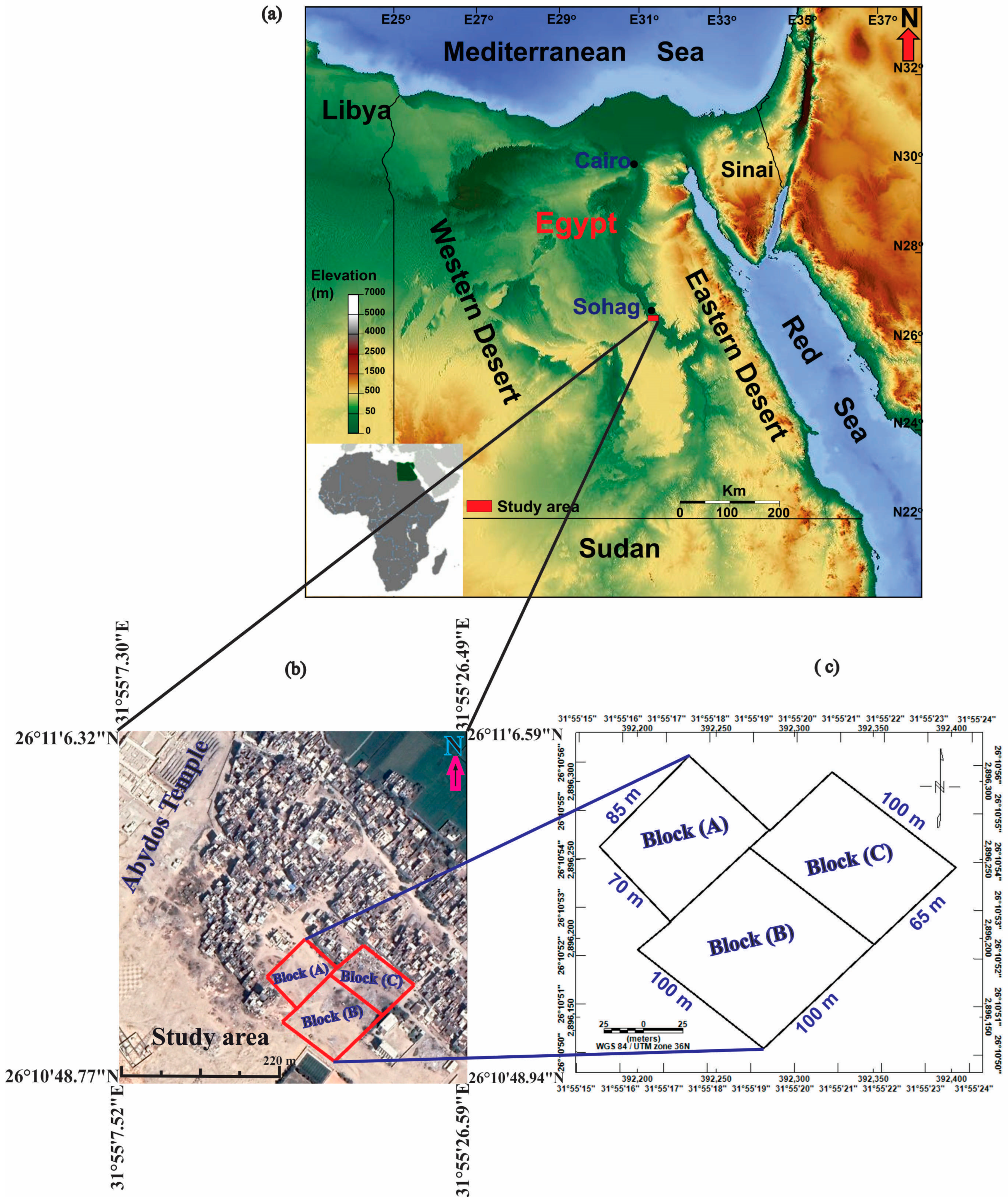
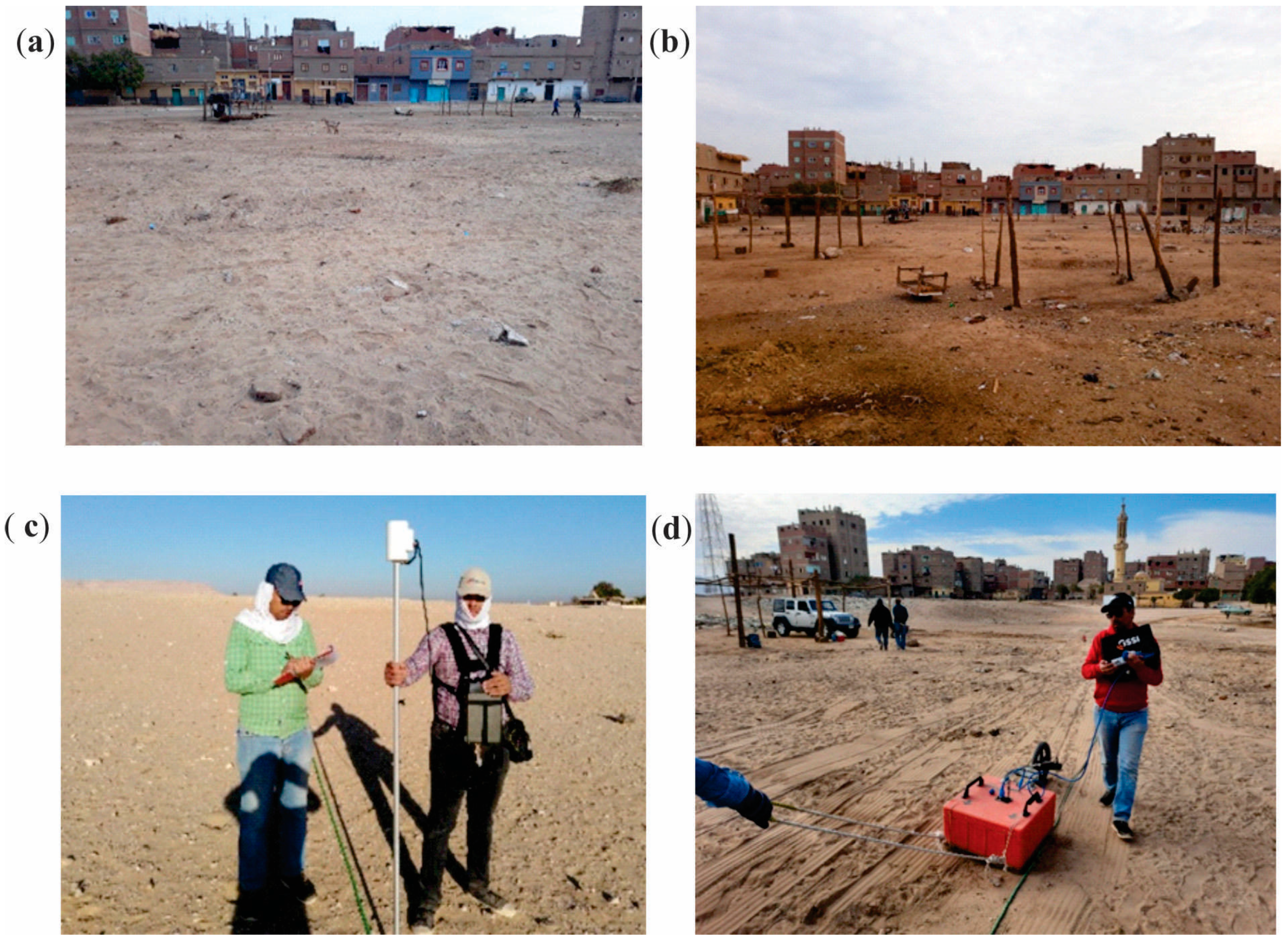
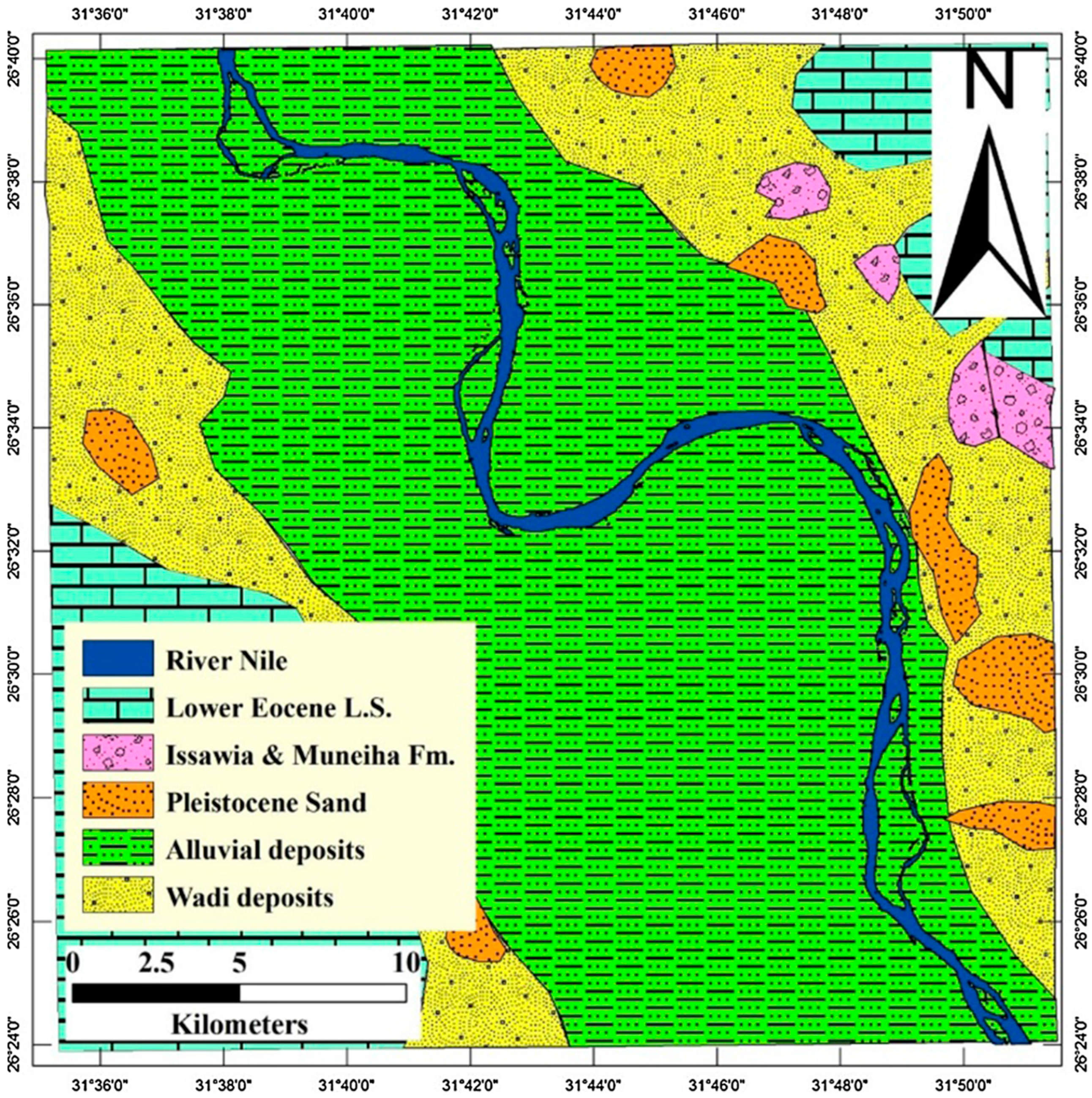
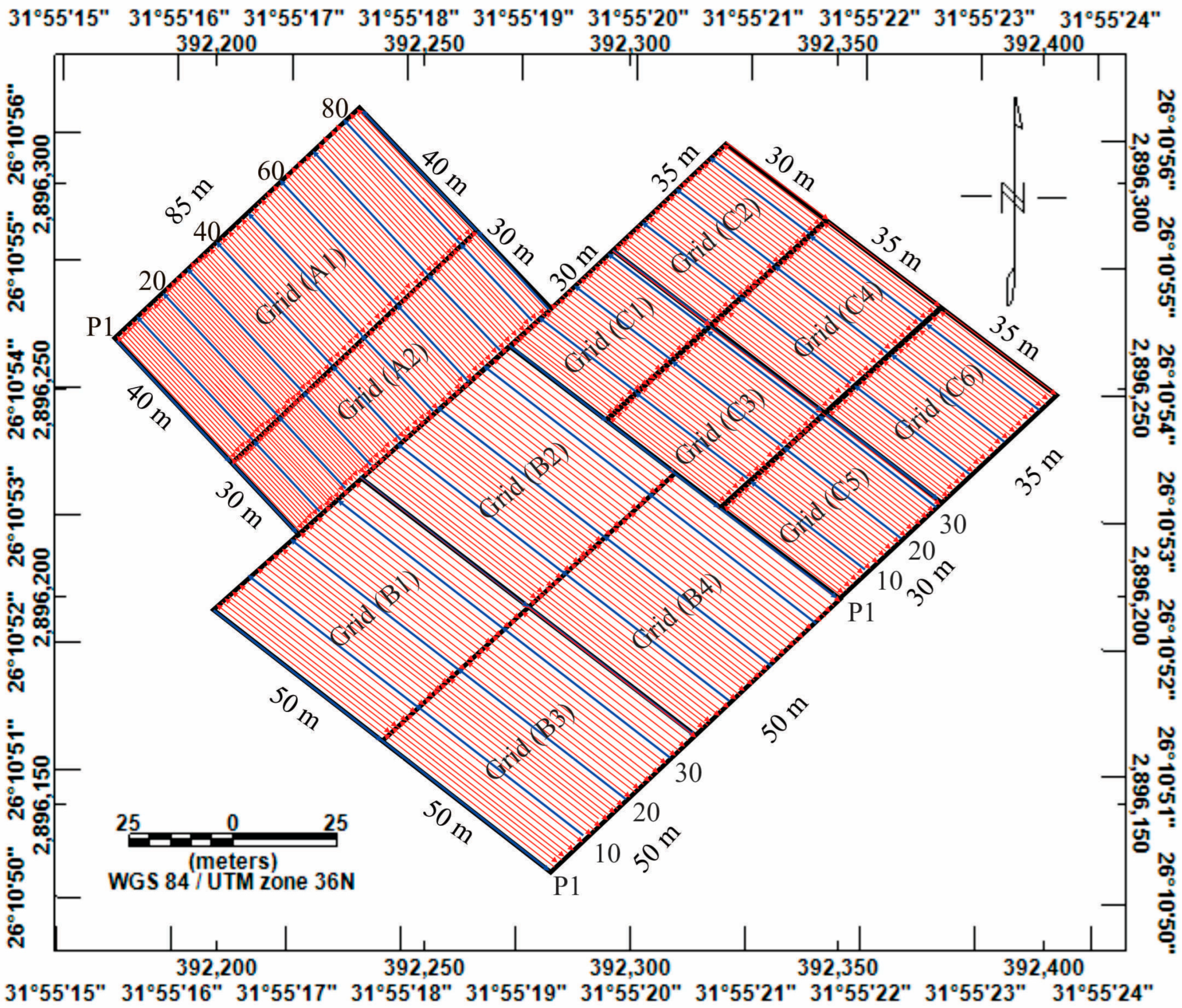
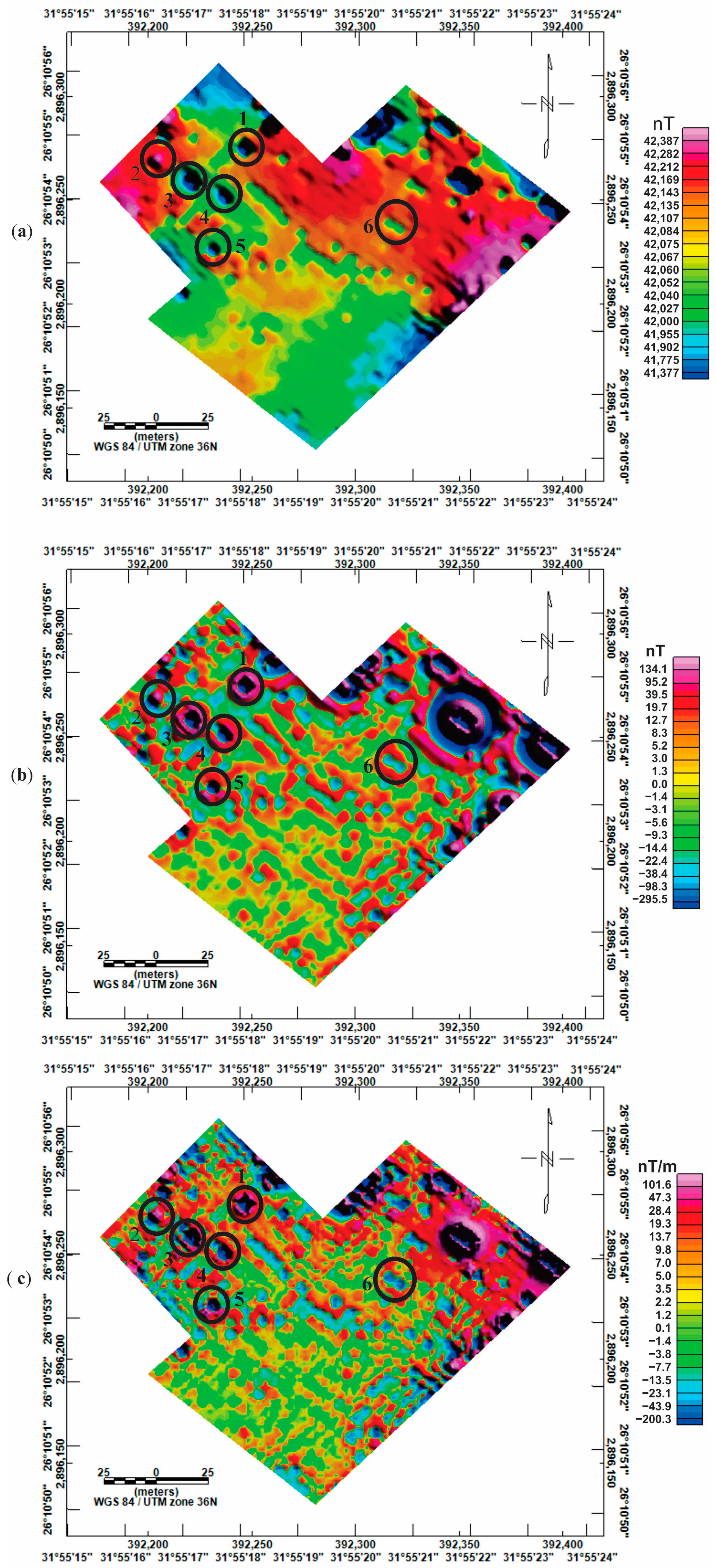
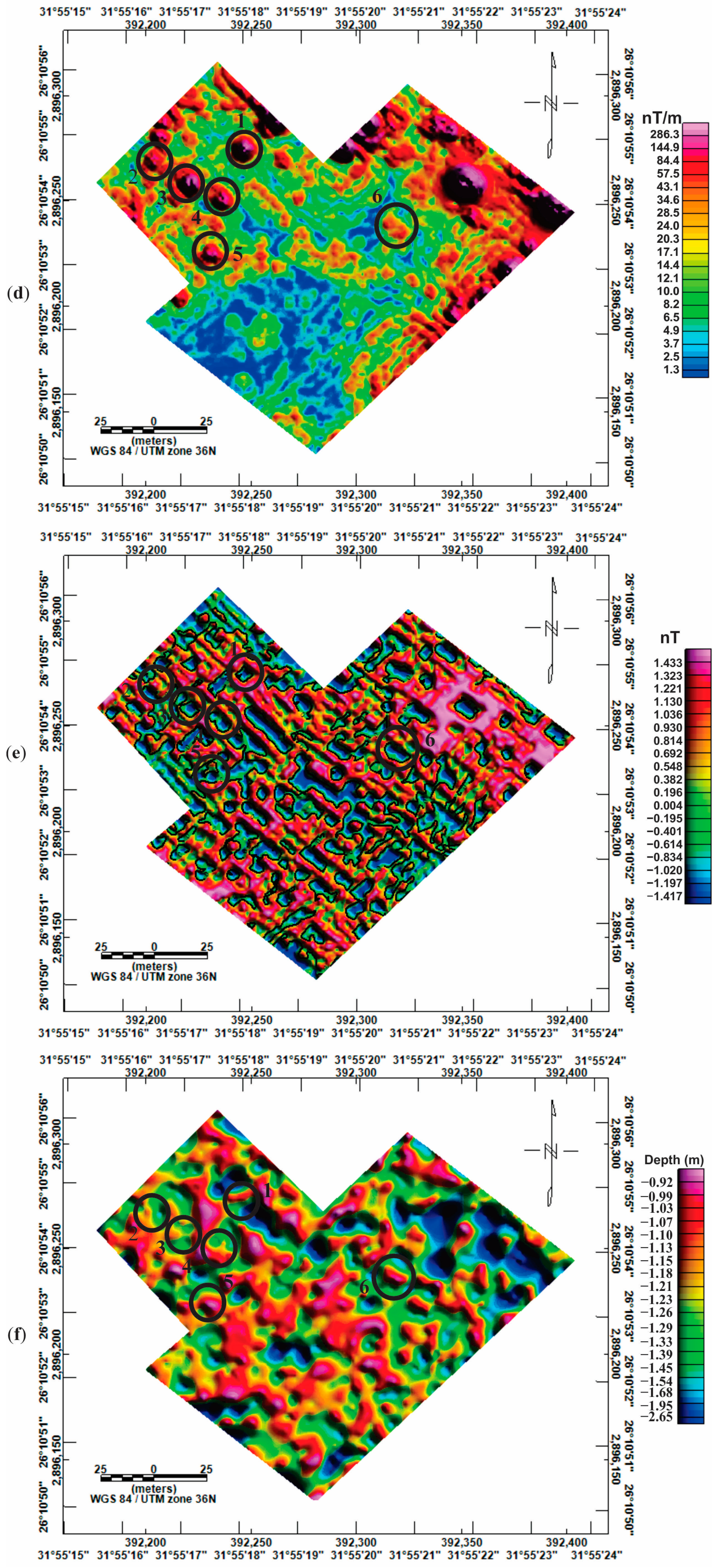
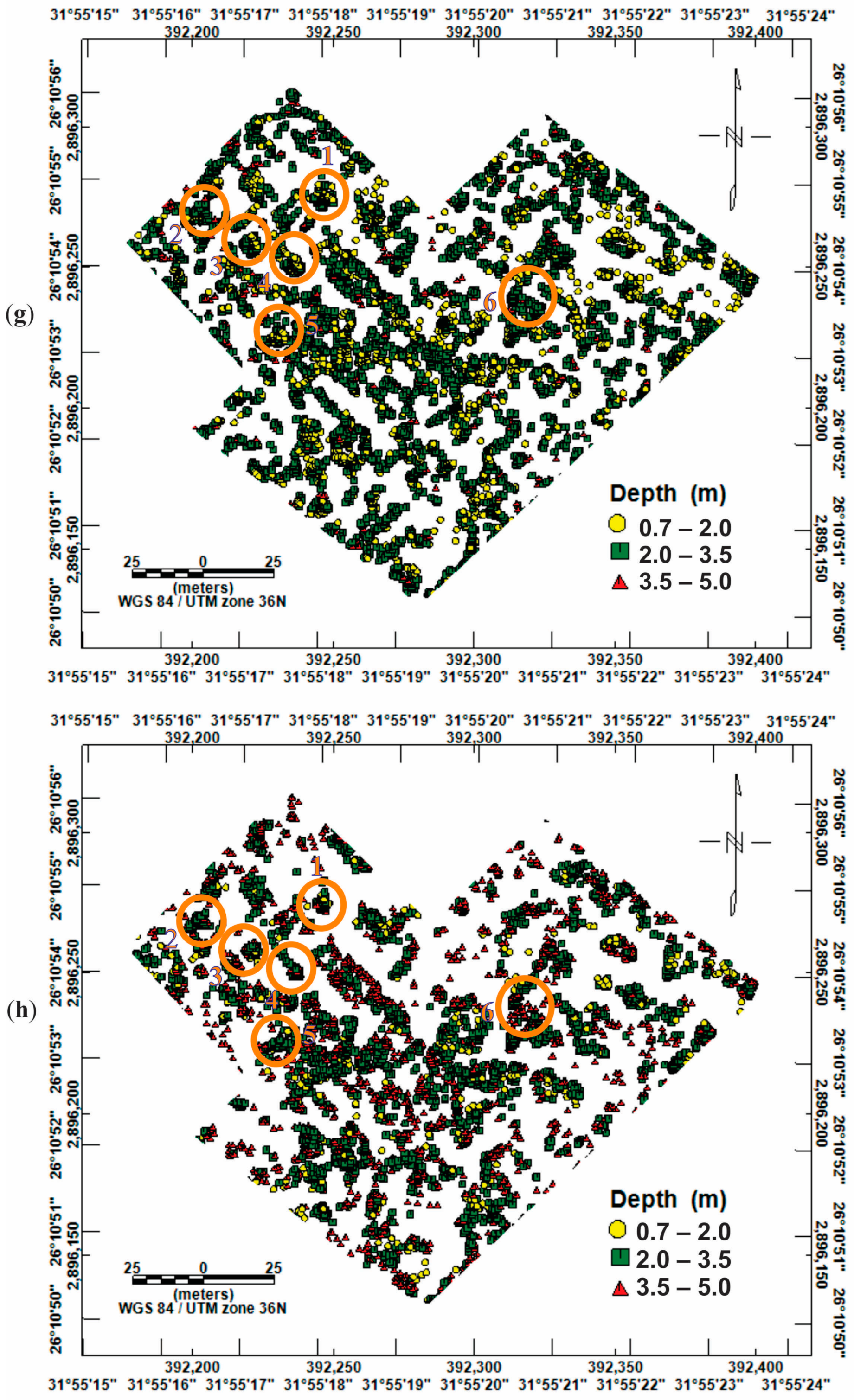
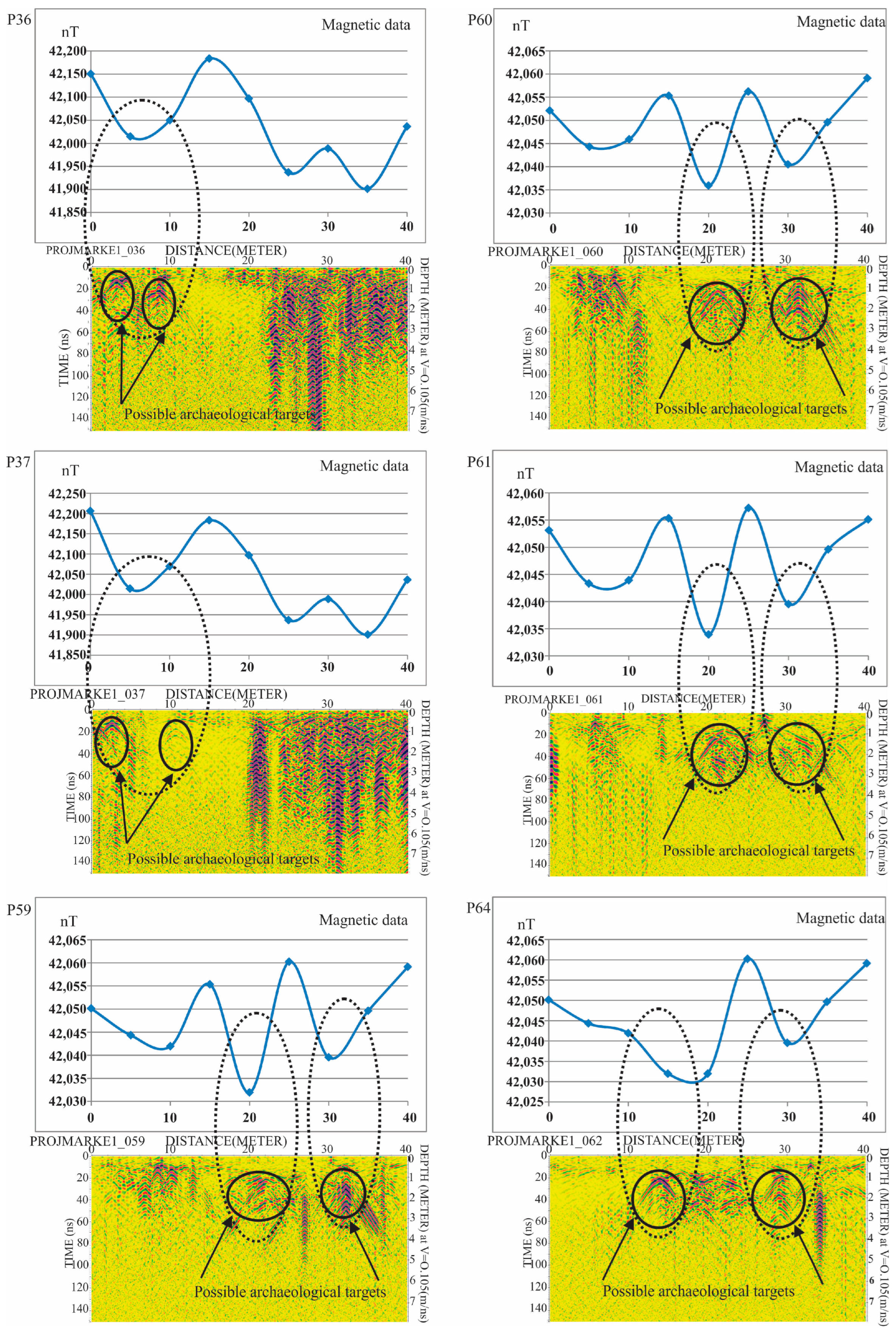
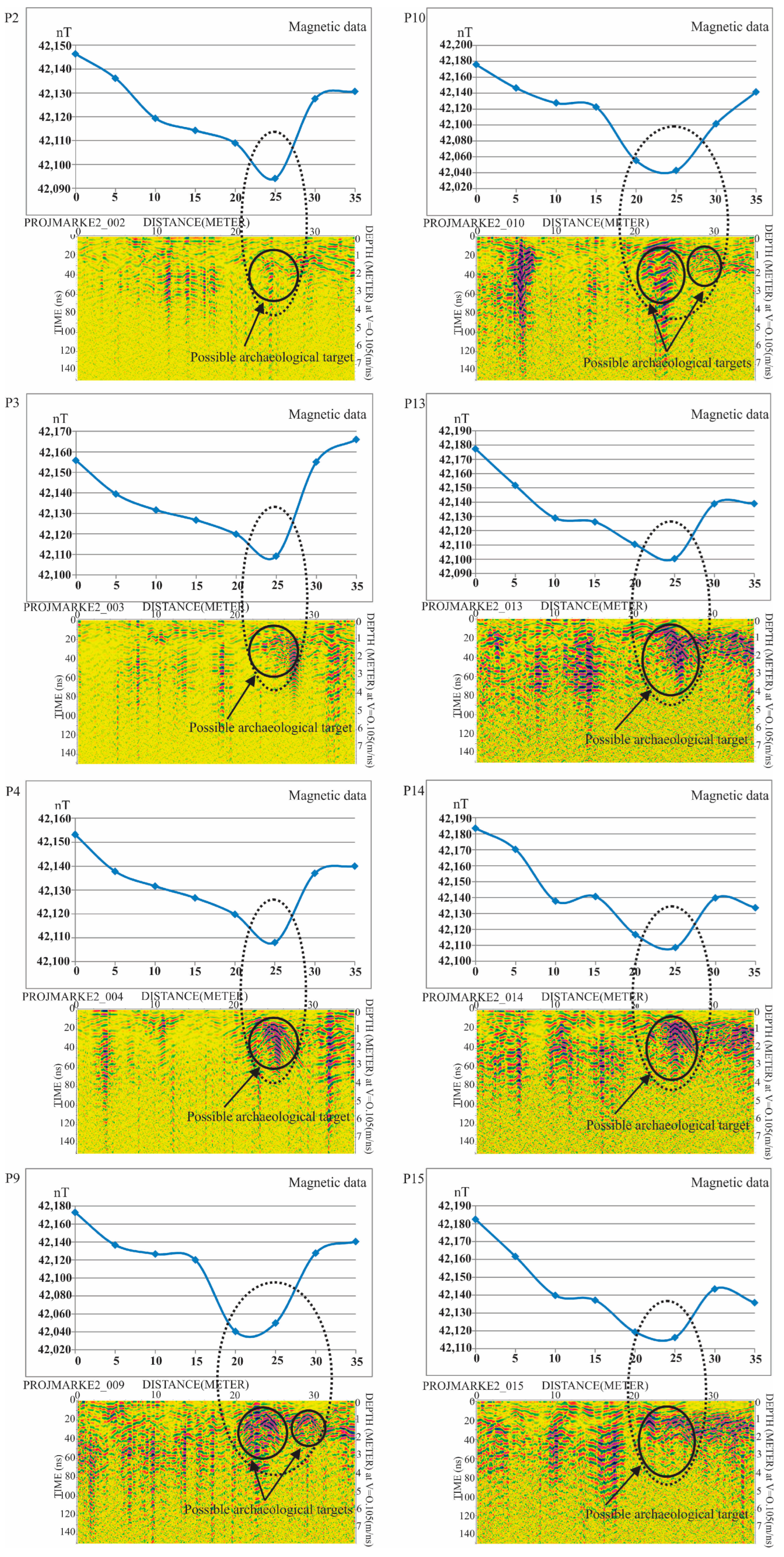
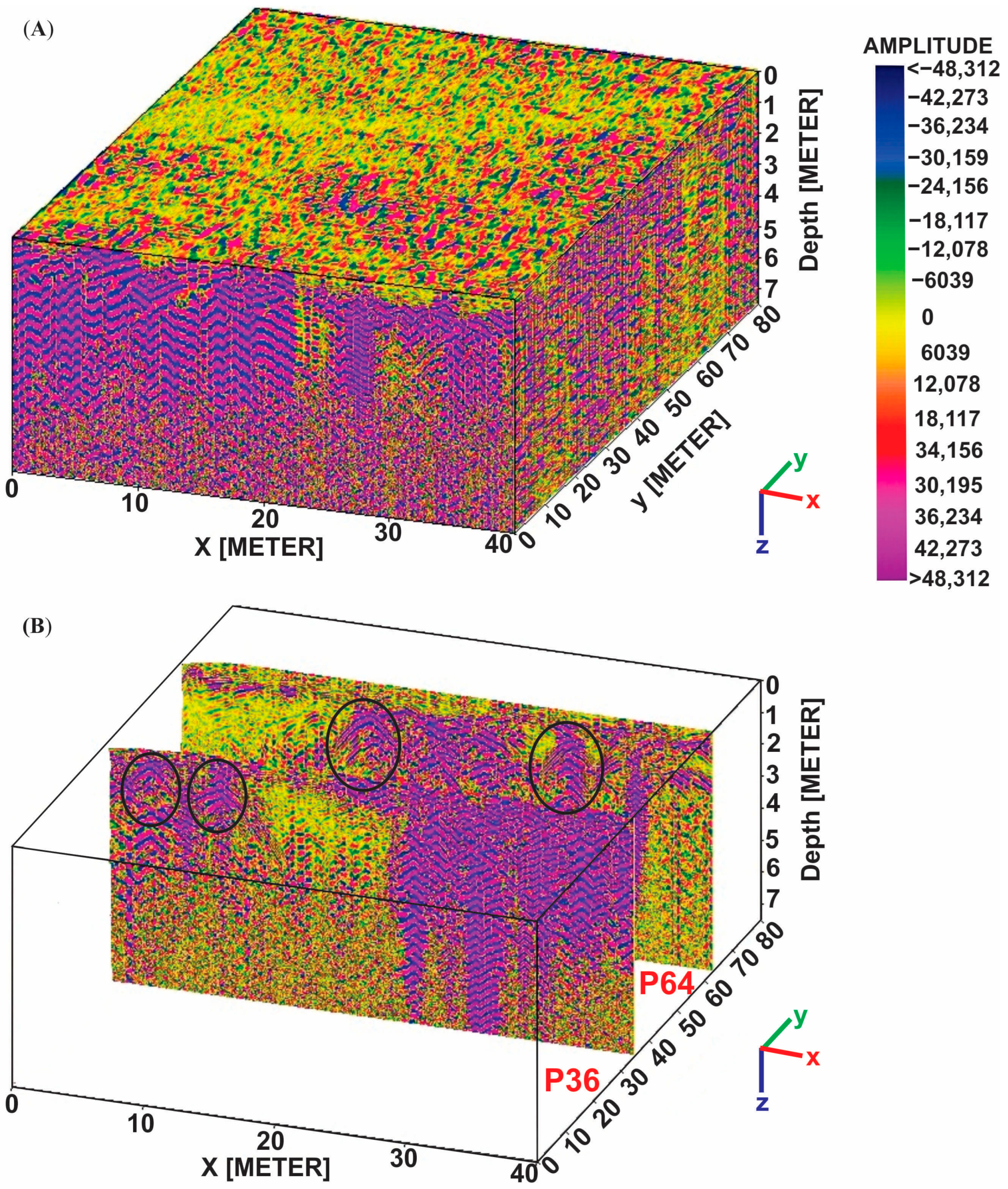
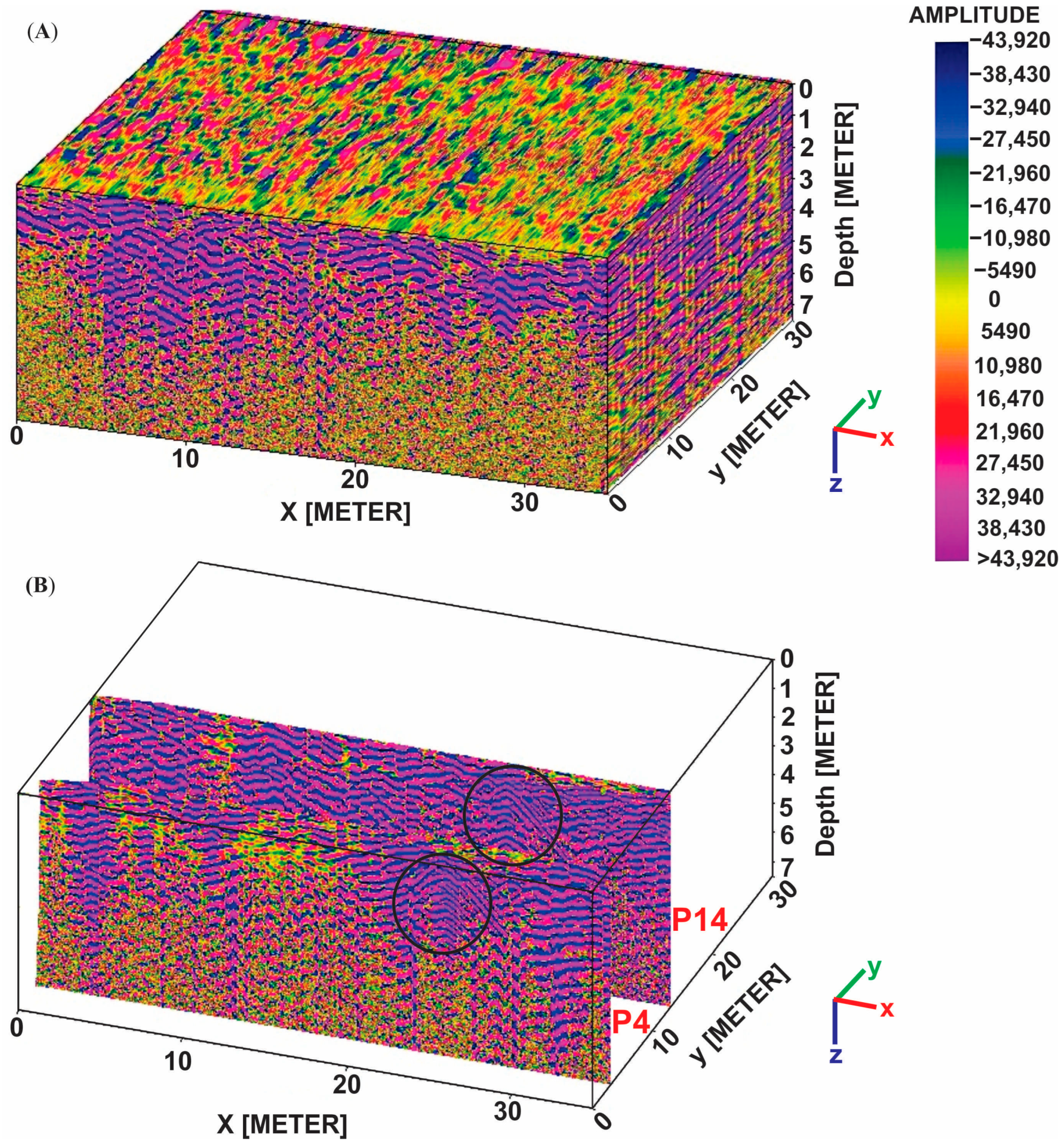
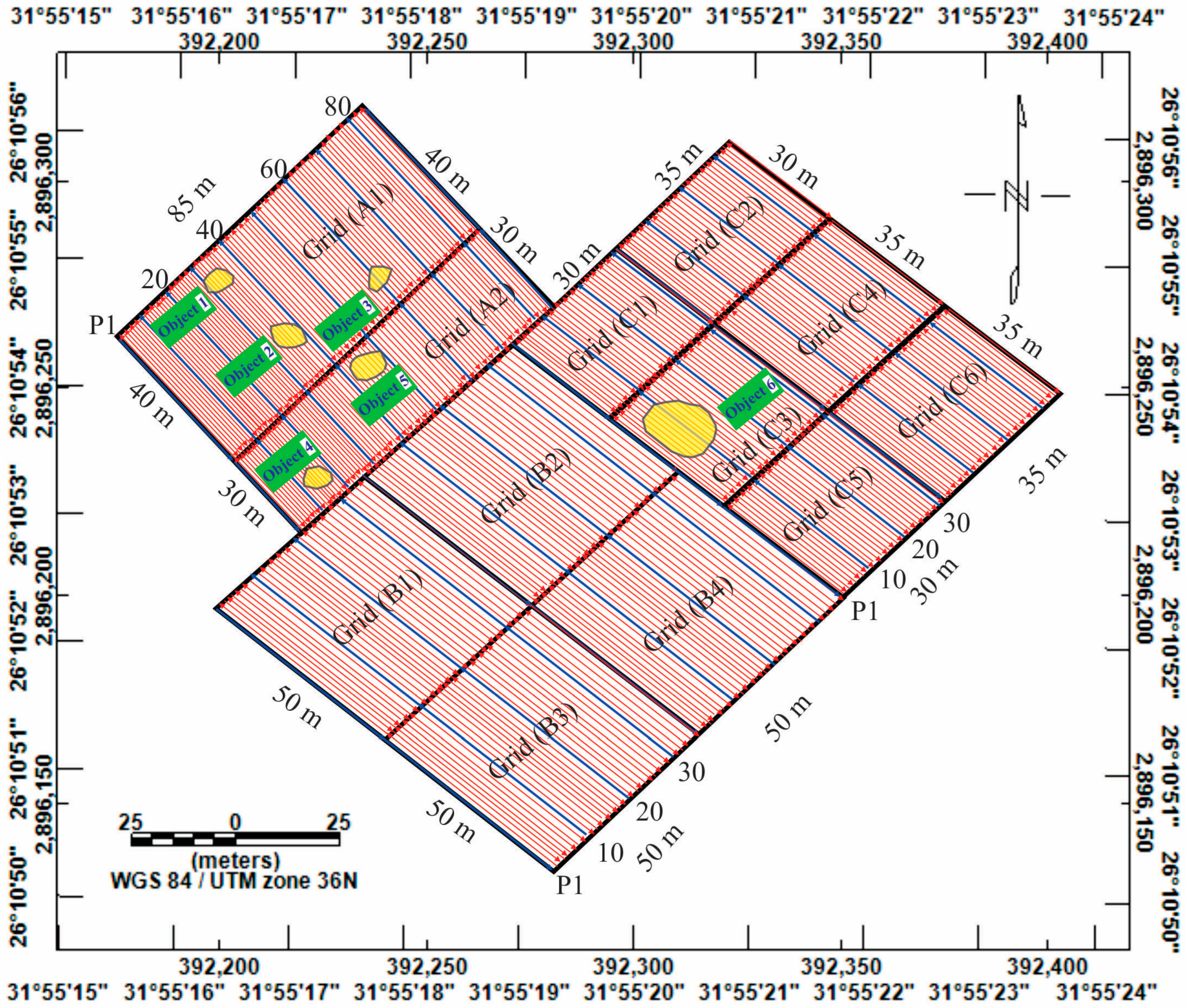
| Formation | Age | Description | References |
|---|---|---|---|
| Wadi deposits | Neogene and Quaternary Recent (Holocene) | A disintegrated product of the neighboring Eocene carbonate, in addition to the sediments’ previously processed material | [43] |
| Alluvial deposits (Nile floodplain) | Pleistocene | Clays and silts with intercalations of sandstone | [43] |
| Dandara | Fluvial fine sand-silt intercalations and accumulations in low-energy environments | [44] | |
| Ghawanim | Sandstone from the Nile showing the heavy mineral’s earliest occurrence | [38] | |
| KomOmbo | Sediments made up of sand and gravel with a lot of large igneous and metamorphic fragments in them. | [45] | |
| Qena | Sands and gravels that are quartzose and devoid of igneous and metamorphic pieces | [43] | |
| Issawia | Late Pliocene/Early Pleistocene | Clastic facies along lake borders and carbonate facies in the middle zones | [43] |
| Muneiha | Early Pliocene | Fluviatile sediments have a predominance of sand, silt, and mud intercalations, as well as bedded grey and brown clays intercalated with thin beds and lenses of silt and fine sand | [44] |
| Drunka | Lower Eocene | A succession of medium- to thick-bedded limestone that contains siliceous concretions of various sizes and is heavily bioturbated in some horizons | [46] |
| Thebes | Massive to layered limestone that contains flint nodules, as well as marls that are abundant in nummulites and planktonic foraminifera | [46] |
| Grid | Profile No. | Recognized Archaeological Anomaly | Surface Distance (m) | Maximum Horizontal Dimension (m) | Two-Way Time (ns) | Depth to Its Top and Bottom (m) | Amplitude (m) |
|---|---|---|---|---|---|---|---|
| (A1) | P36 | 1 | 1 to 5 | 4 | 10 | 0.7 to 1.7 | 1 |
| 2 | 7 to 11 | 4 | 12 | 0.8 to 2 | 1.2 | ||
| P37 | 1 | 0.4 to 4.4 | 4 | 11 | 0.6 to 1.6 | 1 | |
| 2 | 8.3 to 12.3 | 3 | 14 | 0.8 to 1.8 | 1 | ||
| P59 | 1 | 18.2 to 24.2 | 6 | 14 | 0.8 to 3 | 2.2 | |
| 2 | 29.8 to 34.8 | 5 | 12 | 0.6 to 2.8 | 2.2 | ||
| P60 | 1 | 17.8 to 22.9 | 5.1 | 15 | 0.8 to 3.1 | 2.3 | |
| 2 | 29 to 34.9 | 5.9 | 12 | 0.6 to 2.8 | 2.2 | ||
| P61 | 1 | 18.2 to 24.3 | 6.1 | 15 | 0.8 to 2.7 | 1.9 | |
| 2 | 28.1 to 34 | 5.9 | 14 | 0.7 to 2.7 | 2 | ||
| P64 | 1 | 11 to 16.3 | 5.3 | 18 | 0.9 to 2.8 | 1.9 | |
| 2 | 26.8 to 31.9 | 5.1 | 17 | 0.8 to 2.9 | 2.1 | ||
| (C3) | P2 | 1 | 23 to 27 | 4 | 18 | 0.9 to 2.7 | 1.8 |
| P3 | 1 | 23 to 27 | 4 | 14 | 0.8 to 2.7 | 1.9 | |
| P4 | 1 | 22 to 28 | 6 | 13 | 0.7 to 2.6 | 1.9 | |
| P9 | 1 | 21 to 25.8 | 4.8 | 10 | 0.6 to 2.6 | 2 | |
| 2 | 27.3 to 31.3 | 4.3 | 12 | 0.8 to 2.5 | 1.7 | ||
| P10 | 1 | 20.5 to 25.1 | 4.6 | 13 | 0.7 to 2.7 | 2 | |
| 2 | 27 to 31.5 | 4.5 | 15 | 0.8 to 2.4 | 1.6 | ||
| P13 | 1 | 22 to 27 | 5 | 10 | 0.6 to 2.3 | 1.7 | |
| P14 | 1 | 23 to 28 | 5 | 12 | 0.8 to 2.7 | 1.9 | |
| P15 | 1 | 21.8 to 26.6 | 4.8 | 17 | 0.9 to 2.5 | 1.6 |
Disclaimer/Publisher’s Note: The statements, opinions and data contained in all publications are solely those of the individual author(s) and contributor(s) and not of MDPI and/or the editor(s). MDPI and/or the editor(s) disclaim responsibility for any injury to people or property resulting from any ideas, methods, instructions or products referred to in the content. |
© 2023 by the authors. Licensee MDPI, Basel, Switzerland. This article is an open access article distributed under the terms and conditions of the Creative Commons Attribution (CC BY) license (https://creativecommons.org/licenses/by/4.0/).
Share and Cite
Abudeif, A.M.; Abdel Aal, G.Z.; Ramadan, H.S.; Al-Arifi, N.; Bellucci, S.; Mansour, K.K.; Gaber, H.A.; Mohammed, M.A. Geophysical Prospecting of the Coptic Monastery of Apa Moses Using GPR and Magnetic Techniques: A Case Study, Abydos, Sohag, Egypt. Sustainability 2023, 15, 11119. https://doi.org/10.3390/su151411119
Abudeif AM, Abdel Aal GZ, Ramadan HS, Al-Arifi N, Bellucci S, Mansour KK, Gaber HA, Mohammed MA. Geophysical Prospecting of the Coptic Monastery of Apa Moses Using GPR and Magnetic Techniques: A Case Study, Abydos, Sohag, Egypt. Sustainability. 2023; 15(14):11119. https://doi.org/10.3390/su151411119
Chicago/Turabian StyleAbudeif, Abdelbaset M., Gamal Z. Abdel Aal, Hatem S. Ramadan, Nassir Al-Arifi, Stefano Bellucci, Khamis K. Mansour, Hossameldeen A. Gaber, and Mohammed A. Mohammed. 2023. "Geophysical Prospecting of the Coptic Monastery of Apa Moses Using GPR and Magnetic Techniques: A Case Study, Abydos, Sohag, Egypt" Sustainability 15, no. 14: 11119. https://doi.org/10.3390/su151411119
APA StyleAbudeif, A. M., Abdel Aal, G. Z., Ramadan, H. S., Al-Arifi, N., Bellucci, S., Mansour, K. K., Gaber, H. A., & Mohammed, M. A. (2023). Geophysical Prospecting of the Coptic Monastery of Apa Moses Using GPR and Magnetic Techniques: A Case Study, Abydos, Sohag, Egypt. Sustainability, 15(14), 11119. https://doi.org/10.3390/su151411119









